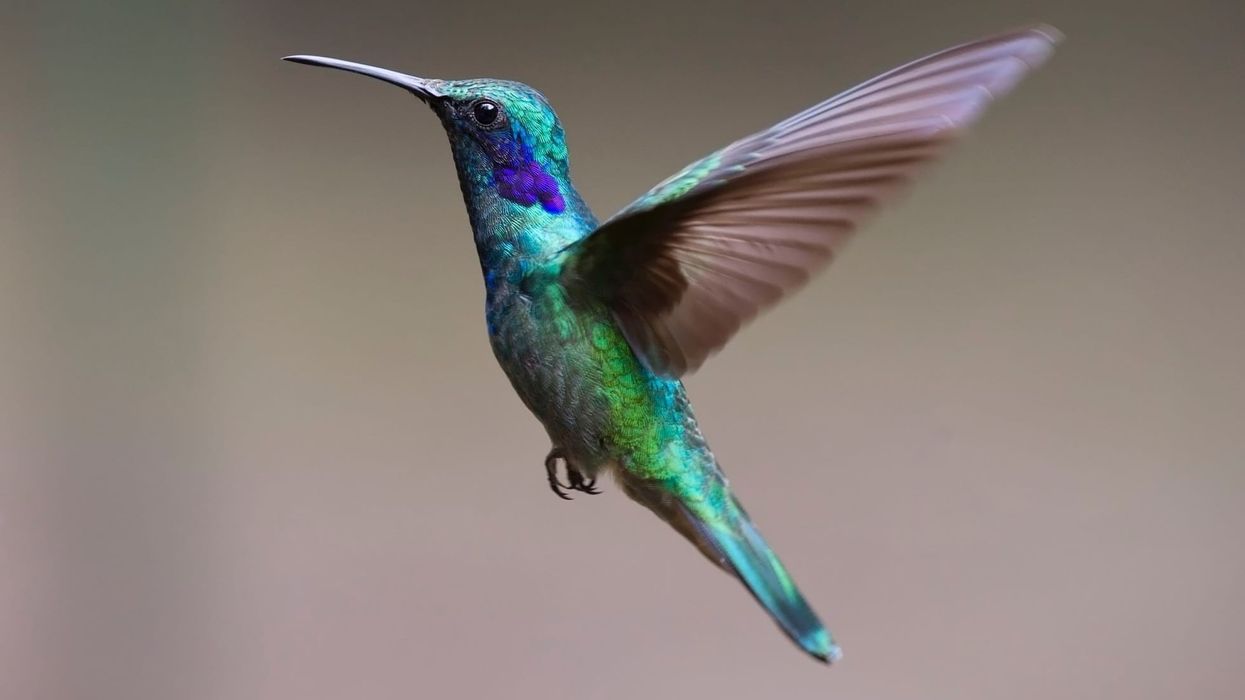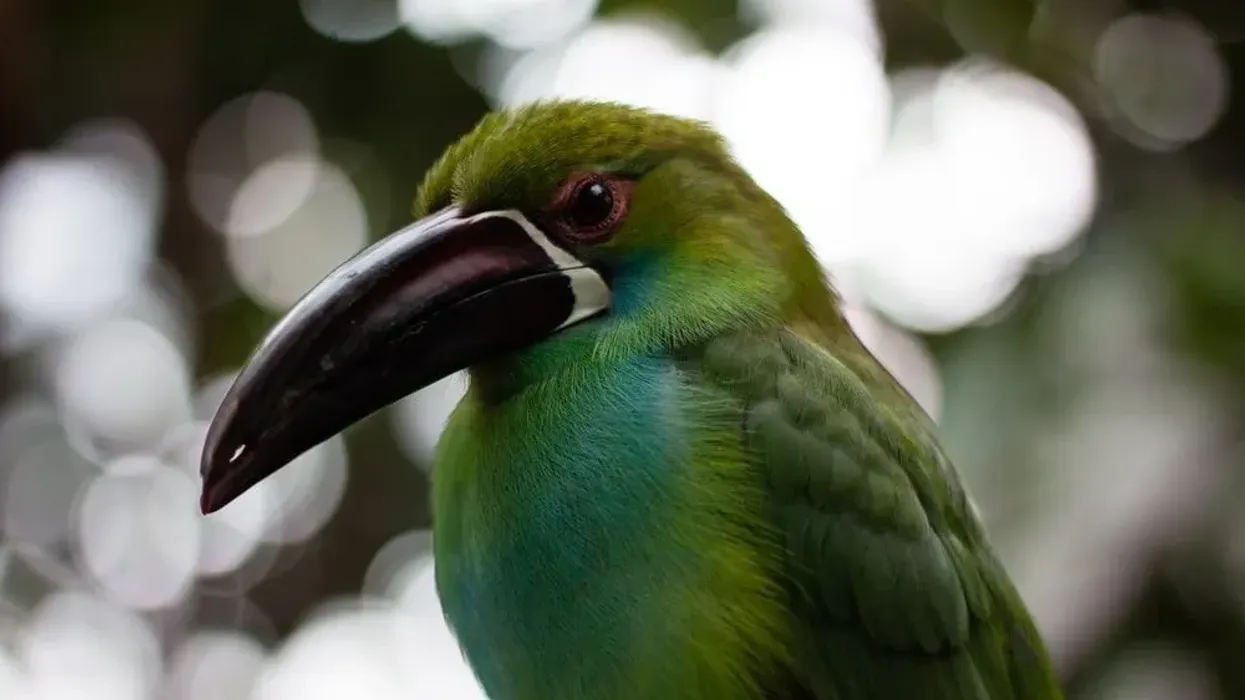The green-breasted mango (Anthracothorax prevostii) belongs to the phylum Chordata, order Apodiformes, and family Anthracotharax. These birds are also known as the Prevost's mango. They are large-sized hummingbirds and are endemic to tropical America.
The adult male of this species is glittery green in color and has a black curved bill with a purple chin. Their purple tail has two bronze-green central tail feathers which make their identification easy.
The female bird of this species has a black chin and a green central stripe bordered with white color running down the breasts and has white-tipped tail feathers. They closely resemble the black-throated mango closely. Young ones and the green-breasted mango male look a little different.
They can be found near Texas, along the Mexican coast, Central America, and South America. They prefer open habitats like forests and gardens for nesting and breeding. They have several subspecies such as Anthracothorax prevostii prevostii, Anthracothorax prevostii gracilirostris, Anthracothorax prevostii hendersoni, Anthracothorax prevostii viridicordatus, and Anthracothorax prevostii iridescens, common in El Salvador, Columbia, and Costa Rica.
Have an interest in birds and want to know about more of them? Here you can know some amazing facts about Anna's hummingbird and tailor bird.
Green-Breasted Mango Interesting Facts
What type of animal is a green-breasted mango?
The green-breasted mango (Anthracothorax prevostii) hummingbird is a type of bird. This species is a tropical bird and can be seen in North American states such as Texas, South America, and Mexico.
What class of animal does a green-breasted mango belong to?
The green-breasted mango bird belongs to the kingdom Animalia, class Aves, family Trochilidae, and order Apodiformes. They have a shiny, glittery body, and the immature young of this species have bronze upperparts. Their scientific name is Anthracothorax prevostii.
How many green-breasted mangos are there in the world?
These species have a very large range of 500,000-4,999,999. The population trend of this species is not known yet but the population is not decreasing. These birds are found in abundance in North America, Central America, and South America. They approach the thresholds for a Least Concern species under the range size criterion.
Where does a green-breasted mango live?
These hummingbirds are tropical birds. Their distribution can be seen in the countries of hot climates like eastern and southern Mexico, Texas, northern American states, Central America, shore islands, Costa Rica, north Colombia, north Venezuela, southern Ecuador, and north-western Peru. They are not extremely rare.
What is a green-breasted mango's habitat?
This hummingbird inhabits areas of deciduous forest of the tropical zone at an elevation range of 3300 ft (1005.8 m). These birds can also be seen in the open areas of large trees, gardens, orchards, and agricultural and cultivated land. The presence of these birds in Central America is mainly made up of the immature species.
Who do green-breasted mangos live with?
These migratory hummingbirds have a solitary nature throughout their life except the time of breeding in all aspects of life other than breeding. They don't even migrate in flocks and also this species of birds prefers to live in solitude in their nest.
How long does a green-breasted mango live?
The lifespan of this North American hummingbird is quite long. Both the males and females can live up to 30 years in good habitat.
How do they reproduce?
These migratory hummingbirds show solitude in their behavior. The male and female only interact with each other at the time of mating.
Males of these hummingbirds court females by forming a U-shaped position and separate immediately after mating. Males mate with many females and females can mate with other males, but the males play no role in nesting or raising the young ones.
These birds make cup-shaped nests using tiny fibers from plants and other raw materials using green moss for providing camouflage and shrubs and leaves for protection. The female lays two eggs and even incubates the eggs all by themselves for around 12-20 days.
What is their conservation status?
According to the International Union for Conservation of Nature (IUCN), this dark blue hummingbird with a green central stripe and vibrant plumage is a common bird in North America, Texas, and Mexico. Their status is under the category of a Least Concern (LC) species of IUCN.
Green-Breasted Mango Fun Facts
What does the green-breasted mango look like?
The green-breasted mango (Anthracothorax prevostii) is a native bird of North America that falls under hummingbirds and they mainly live in Texas and Mexico. The green-breasted mango description has some amazing facts.
They are one of the shiniest and glittery birds. They are large, fluffy, and have an arched black bill.
Male birds of this species have a dark and deep green body with a black throat and purple tail. The green-breasted mango female bird and the juvenile green-breasted mango have a black stripe on the center of their throat and breast.
How cute are they?
This hummingbird has a colorful body. The tail feathers are dark pink in the inside, the underparts are dark blue and have a shiny glittery plumage with a dark stripe. They can be considered to be one of the cutest birds with an attractive plumage.
How do they communicate?
Throated mango hummingbirds are solitary birds and interact very little with other birds. They don't socialize much.
The little they do communicate is by using various vocalizations and flying. They have a distinctive call sounding like a 'tsip' which they use to talk and interact in case of emergencies when the territory of these birds is invaded by a predator. Also, they tend to fly in front of their group mates to chase them.
How big is a green-breasted mango?
The breasted mango (Anthracothorax prevostii) is a small bird with a length of 4.3-4.7 in (11–12 cm). They are two times the size of the rufous hummingbird which is 2.8-3.6 in (7.3-9.1 cm) long.
How fast can a green-breasted mango fly?
These species are fast fliers and can reach up to a speed of 34.27 mph (55 kph). The wing beat can range between 720-5000 times per minute.
How much does a green-breasted mango weigh?
The breasted mango bird (Anthracothorax prevostii) weighs around 0.25 oz (7.2 g) which is three times the weight of a bee hummingbird of the same family Trochilidae.
What are the male and female names of the species?
Native to Texas and Mexico, these birds do not have any specific names for their males and females.
What would you call a baby green-breasted mango?
Like other birds, babies of green-breasted mangos are called chicks. Also, the development stage decides whether they should be called hatchlings, nestlings, or fledglings.
What do they eat?
The green-breasted mango bird of North America mainly feeds on the nectar of bright flowers that have a high sugar content in them. Their long tongue helps them to get nectar from the flowers. They also eat spiders, bugs, gnats, small bees, wasps, caterpillars, and insects to include protein in their diet.
Are they dangerous?
They are not dangerous until they feel threatened. They can become very aggressive and do not appreciate the presence of others around them.
Would they make a good pet?
They are not social birds and if kept under certain boundaries, they might show their aggressive side. In the United States, it is illegal to own them.
Did you know...
Hummingbirds have quite an interesting reason for their name. They beat their wings so fast that it makes a 'humming' noise and is how they got this name.
They are the only type of birds that can fly backwards.
They have a poor sense of smell.
What is the green-breasted mango's call?
The green-breasted mango makes a very high-pitched called which sounds like a 'tsip' and the song is like 'kazick-kazee'.
Why are they called green-breasted mangos?
These vibrant birds of North America have shiny dark green and black breasts. A dark blue color can also be seen on their breast area. One more interesting fact is that they live in mango trees but do not eat mangos at all. This is how they were given the name, green-breasted mango birds.
Here at Kidadl, we have carefully created lots of interesting family-friendly animal facts for everyone to discover! For more relatable content, check out these Cockatoo facts and the Hoopoe facts for kids.
You can even occupy yourself at home by coloring in one of our free printable yellow breasted bunting coloring pages.









